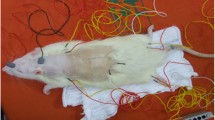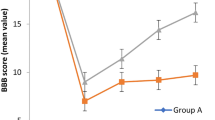Abstract
FK506 (tacrolimus), a potent immunosuppressive drug primarily used for reduction of allograft rejection in organ transplantation, also offers neuroprotection after central nervous system injury. FK506-mediated immunosuppression and neuroprotection may occur through different mechanisms that could affect neurological recovery and the severity of spinal lesions where cells transplantation therapy is combined with FK506 application. We assessed effects of long-term FK506 administration using the same dose regiment (1 mg/kg/day for 6 weeks) as is used in spinal cord transplantation studies following a balloon-compression induced spinal cord injury (SCI). Body weight and locomotor recovery quantified by the BBB (Basso-Beattie-Bresnehan) locomotor rating scale were evaluated for up to 42 days post-injury. The area of the preserved spinal cord tissue within a 13 mm segment of the spinal cord (lesion epicenter and 6 mm rostral-caudal) was examined histologically. The results showed no significant effects of FK506 on spinal cord tissue sparing or improvement of locomotor recovery. However, body weight fell significantly (P < 0.05) with FK506 treatment when compared with placebo from day 7 until sacrifice. In our experimental design, long-term FK506 treatment did not affect the parameters of outcome following balloon-compression SCI in the rat; however, multiple effects of FK506 should be taken into account when evaluating the outcomes in transplantation studies.




Similar content being viewed by others
References
Allison AC (2000) Immunosuppresive drugs: the first 50 years and glance forward. Immunopharmacology 47:63–83. doi:10.1016/S0162-3109(00)00186-7
Arii T, Kamiya T, Arii K, Ueda M, Nito C, Katsura KI, Katayama Y (2001) Neuroprotective effect of immunosuppressant FK506 in transient focal ischemia in rat: therapeutic time window for FK506 in transient focal ischemia. Neurol Res 23:755–760. doi:10.1179/016164101101199135
Bareyre FM (2008) Neuronal repair and replacement in spinal cord injury. J Neurol Sci 265:63–72. doi:10.1016/j.jns.2007.05.004
Basso DM, Bettie MS, Bresnahan JC (1995) A sensitive and reliable locomotor rating scale for open field testing in rats. J Neurotrauma 12:1–21. doi:10.1089/neu.1995.12.1
Bavetta S, Hamlyn PJ, Burnstock G, Lieberman AR, Anderson PN (1999) The effects of FK506 on dorsal column axons following spinal cord injury in adult rats: neuroprotection and local regeneration. Exp Neurol 158:382–393. doi:10.1006/exnr.1999.7119
Benetoli A, Dutra AM, Paganelli RA, Senda DM, Franzin S, Milani H (2007) Tacrolimus (FK506) reduces hippocampal damage but fails to prevent learning and memory deficits after transient, global cerebral ischemia in rats. Pharmacol Biochem Behav 88:28–38. doi:10.1016/j.pbb.2007.07.001
Čížková D, Rosocha J, Vanický I, Jergová S, Čížek M (2006) Transplants of human mesenchymal stem cells improve functional recovery after spinal cord injury in the rat. Cell Mol Neurobiol 26:1167–1180
Čížková D, Kakinohana O, Kuchárová K, Maršala S, Johe K, Hazel T, Hefferan MP, Maršala M (2007) Functional recovery in rats with ischemic paraplegia after spinal grafting of human spinal stem cells. Neuroscience 147:546–560. doi:10.1016/j.neuroscience.2007.02.065
Furuichi Y, Katsuta K, Maeda M, Ueyama N, Moriguchi A, Matsuoka N, Goto T, Yanagihara T (2003) Neuroprotective action of tacrolimus (FK506) in focal and global cerebral ischemia in rodents: dose dependency, therapeutic time window and long term efficacy. Brain Res 965:137–145. doi:10.1016/S0006-8993(02)04151-3
Furuichi Y, Noto T, Li JY, Oku T, Ishiye M, Moriguchi A, Aramori I, Matsuoka N, Mutoh S, Yanagihara T (2004) Multiple modes of action of tacrolimus (FK506) for neuroprotective action on ischemic damage after transient focal cerebral ischemia in rats. Brain Res 1014:120–130. doi:10.1016/j.brainres.2004.04.031
Gundersen HJ, Jensen EB (1987) The efficiency of systemic sampling in stereology and its prediction. J Microsc 147:229–263
Hailer NP (2008) Immunosuppression after traumatic or ischemic CNS damage: it is neuroprotective and illuminates the role of microglia cells. Prog Neurobiol 84:211–233. doi:10.1016/j.pneurobio.2007.12.001
Hayashi Y, Shumsky JS, Connors T, Otsuka T, Fischer I, Tessler A, Murray M (2005) Immunosuppression with either cyclosporine A or FK506 supports survival of transplanted fibroblasts and promotes growth of host axons into the transplant after spinal cord injury. J Neurotrauma 22:1267–1281. doi:10.1089/neu.2005.22.1267
Jendelová P, Herynek V, Urdzíková L, Glogarová K, Kroupová J, Andersson B, Bryja V, Syková E (2004) Magnetic resonance tracking of transplanted bone marrow and embryonic stem cells labeled by iron oxide nanoparticles in rat brain and spinal cord. J Neurosci Res 76:232–243. doi:10.1002/jnr.20041
Kakinohana O, Čížková D, Tomori Z, Hedlund E, Maršala S, Isacson O, Maršala M (2004) Region-specific cell grafting into cervical and lumbar spinal cord in rat: a qualitative and quantitative stereological study. Exp Neurol 190:122–132. doi:10.1016/j.expneurol.2004.07.014
Kino T, Hatanaka H, Miyata S (1987) FK506, a novel immunosuppressant isolated from a streptomyces: III. Immunossuppresive effect of FK-506 in vitro. J Antibiot (Tokyo) 40:1256–1265
Liu J, Farmer J, Lane W, Friedman J, Weissman I, Schreiber S (1991) Calcineurin is a common target of cyclophilin-cyclosporin A and FKBP-FK506 complexes. Cell 66:807–815. doi:10.1016/0092-8674(91)90124-H
Lopez-Vales R, Fores J, Navarro X, Verdu E (2006) Olfactory ensheathing glia graft in combination with FK506 administration promote repair after spinal cord injury. Neurobiol Dis 24:443–454. doi:10.1016/j.nbd.2006.08.001
Lyons WE, George EB, Dawson TM, Steiner JP, Snyder SH (1994) Immunossupressant FK506 promotes neurite outgrowth in cultures of PC12 cells and sensory ganglia. Proc Natl Acad Sci USA 91:3191–3195. doi:10.1073/pnas.91.8.3191
Madsen JR, MacDonals P, Irwin N, Goldberg DE, Yao GL, Meiri KF, Rimm IJ, Stieg PE, Benowitz LI (1998) Tacrolimus (FK506) increases neuronal expression of GAP-43 and improves functional recovery after spinal cord injury in rats. Exp Neurol 154:673–683. doi:10.1006/exnr.1998.6974
Marmarou CR, Povlishock JT (2006) Administration of immunophilin ligand FK506 differentially attenuates neurofilament compaction and impaired axonal transport in injured axons following diffuse traumatic brain injury. Exp Neurol 197:353–362. doi:10.1016/j.expneurol.2005.10.003
Maršala M, Kakinohana O, Yaks TL, Tomori Z, Maršala S, Čížková D (2004) Spinal implantation of hNT neurons and neuronal precursors graft survival and functional effects in rats with ischemic spastic paraplegia. Eur J NeuroSci 20:2401–2414. doi:10.1111/j.1460-9568.2004.03702.x
Matsuda S, Shibasaki F, Takehana K, Mori H, Nishida E, Koyasu S (2000) Two distinct action mechanisms of immunophilin-ligand complexes for the blockade of T-cell activation. EMBO Rep 1:428–434. doi:10.1093/embo-reports/kvd090
Nito C, Kamiya T, Ueda M, Arii T, Katayama Y (2004) Mild hypothermia enhances the neuroprotective effects of FK506 and expands its therapeutic window following transient focal ischemia in rats. Brain Res 1008:179–185. doi:10.1016/j.brainres.2004.02.031
Nottingham S, Knapp P, Springer J (2002) FK506 treatment inhibits caspase-3 activation and promotes oligodendroglial survival following traumatic spinal cord injury. Exp Neurol 177:242–251. doi:10.1006/exnr.2002.7975
Ondrejčák T, Vanický I, Gálik J (2004) Ischemic preconditioning does not improve neurologic recovery after spinal cord compression injury in the rat. Brain Res 995:267–273. doi:10.1016/j.brainres.2003.10.009
Reeves TM, Philips LL, Lee NN, Povlishock JT (2007) Preferential neuroprotective effect of tacrolimus (FK506) on unmyelinated axons following traumatic brain injury. Brain Res 1154:225–236. doi:10.1016/j.brainres.2007.04.002
Saganová K, Orendáčová J, Čížková D, Vanický I (2008) Limited minocycline neuroprotection after balloon-compression spinal cord injury in the rat. Neurosci Lett 433:246–249. doi:10.1016/j.neulet.2008.01.041
Sigal NH, Dumont FJ (1992) Cyclosporin A, FK506 and rapamycin: pharmacological probes of lymphocyte signal transduction. Annu Rev Immunol 10:519–560
Sosa I, Reyes O, Kuffler DP (2005) Immunosuppressants: neuroprotection and promoting neurological recovery following periferal nerve and spinal cord lesions. Exp Neurol 195:7–15. doi:10.1016/j.expneurol.2005.04.016
Syková E, Jendelová P (2005) Magnetic resonance tracking of implanted embryonic and adult stem cells in injured brain and spinal cord. Ann N Y Acad Sci 1049:146–160. doi:10.1196/annals.1334.014
Tachibana T, Shiiya N, Kunihara T, Wakamatsu Y, Kudo AF, Ooka T, Watanabe S, Yasuda K (2005) Immunophilin ligands FK506 and cyclosporine A improve neurologic and histopathologic outcome after transient spinal cord ischemia in rabbits. J Thorac Cardiovasc Surg 129:123–128. doi:10.1016/j.jtcvs.2004.04.047
Takamatsu H, Tsukada H, Noda A, Kakiuchi T, Nishiyama S, Nishimura S, Umemura K (2001) FK506 attenuates early ischemic neuronal death in a monkey model of stroke. J Nucl Med 42:1833–1840
Tokime T, Nozaki K, Kikuchi H (1996) Neuroprotective effect of FK506, an immunosuppressant, on transient global ischemia in gerbil. Neurosci Lett 206:81–84. doi:10.1016/S0304-3940(96)12438-1
Urdzíková L, Jendelová P, Glogarová K, Burian M, Hájek M, Syková E (2006) Transplantation of bone marrow stem cells as well as mobilization by granulocyte-colony stimulating factor promotes recovery after spinal cord injury in rats. J Neurotrauma 23:1379–1391. doi:10.1089/neu.2006.23.1379
Vanický I, Urdzíková L, Saganová K, Čížková D, Gálik J (2001) A simple and reproducible model of spinal cord injury induced by epidural balloon inflation in the rat. J Neurotrauma 18:1399–1407. doi:10.1089/08977150152725687
Vanický I, Urdzíková L, Saganová K, Maršala M (2002) Intrathecal metylprednisolone does not improve outcome after severe spinal cord injury in the rat. Neurosci Res Commun 31:183–191. doi:10.1002/nrc.10051
Voda J, Yamaji T, Gold BG (2005) Neuroimmunophilin ligands improve functional recovery and increase axonal growth after spinal cord hemisections in rat. J Neurotrauma 22:1150–1161. doi:10.1089/neu.2005.22.1150
Voda J, Hama A, Sagen J (2007) FK506 reduces the severity of cutaneous hypersensitivity in rats with a spinal cord contusion. Neurosci Res 58:95–99. doi:10.1016/j.neures.2007.02.004
Willerth SM, Sakiyama-Elbert SH (2008) Cell therapy for spinal cord regeneration. Adv Drug Deliv Rev 60:263–276. doi:10.1016/j.addr.2007.08.028
Yagita Y, Kitagawa K, Matsushita K, Taguchi A, Mabuchi T, Ohtsuki T, Yanagihara T, Matsumoto M (1996) Effect of immunosuppressant FK506 on ischemia-induced degeneration of hippocampal neurons in gerbils. Life Sci 59:1643–1650. doi:10.1016/0024-3205(96)00495-X
Zawadska M, Kaminska B (2005) A novel mechanism of FK506-mediated neuroprotection: downregulation of cytokine expression in glial cells. Glia 49:36–51. doi:10.1002/glia.20092
Acknowledgments
This research was supported by grants from the Slovak Academy of Sciences VEGA/2/0092/08, VEGA/2/0058/08, VEGA/2/0019/08, VEGA/2//6212/27 and APVV 51-0314-06 grant.
Author information
Authors and Affiliations
Corresponding author
Rights and permissions
About this article
Cite this article
Saganová, K., Orendáčová, J., Šulla, I. et al. Effects of Long-Term FK506 Administration on Functional and Histopathological Outcome after Spinal Cord Injury in Adult Rat. Cell Mol Neurobiol 29, 1045–1051 (2009). https://doi.org/10.1007/s10571-009-9395-1
Received:
Accepted:
Published:
Issue Date:
DOI: https://doi.org/10.1007/s10571-009-9395-1




